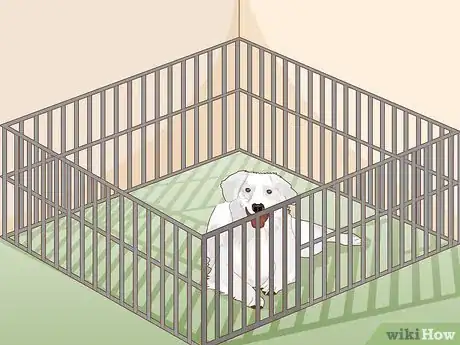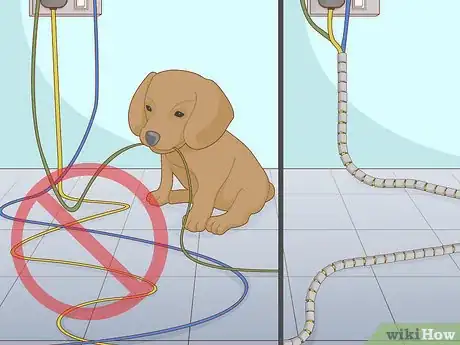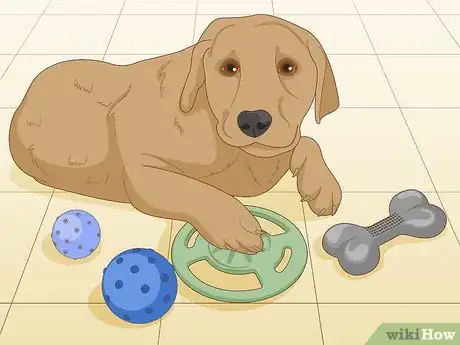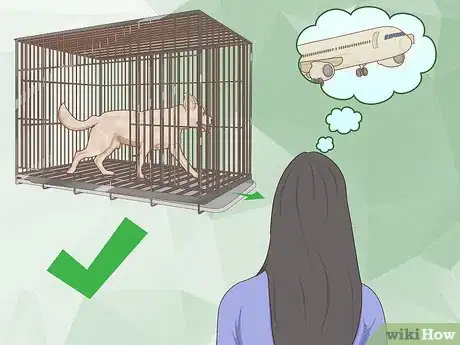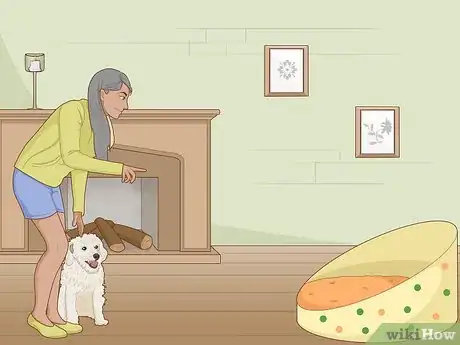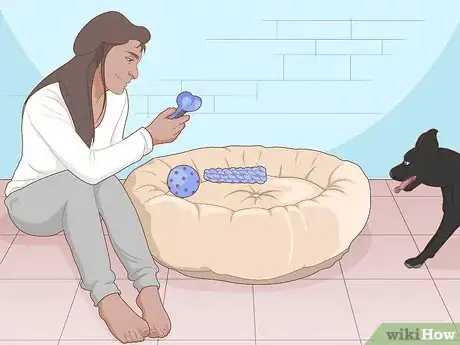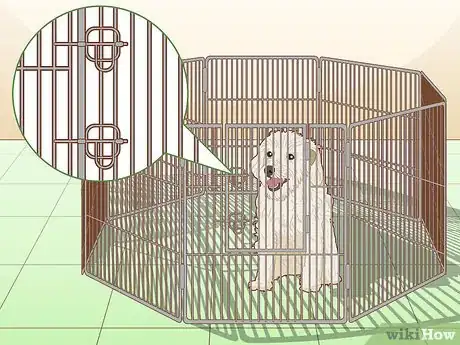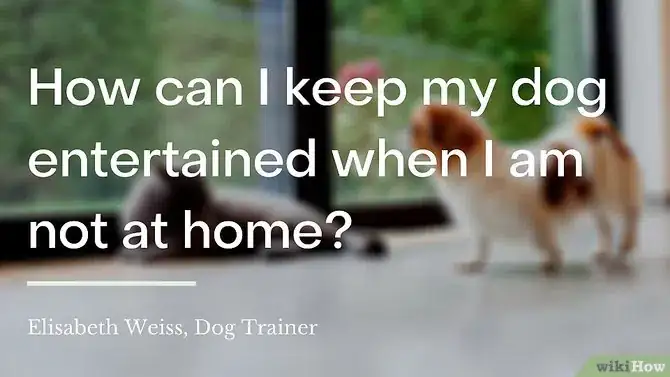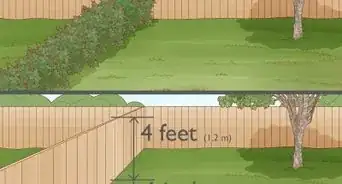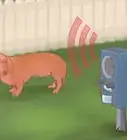This article was co-authored by Elisabeth Weiss. Elisabeth Weiss is a Professional Dog Trainer and owner of Dog Relations NYC, a dog training service in New York, New York. Elisabeth relies on science-based, force-free, and reward-based techniques. Elisabeth offers behavior training, puppy manners, body awareness and injury prevention, diet, exercise and dog nutrition services. Her work has been featured in New York Magazine and on the Dog Save the People podcast. She also trained all the dogs in the movie "Heart of a Dog" by Laurie Anderson that features Elisabeth's journey with Laurie Anderson's and Lou Reed's dog Lolabelle and how her passion for playing the keyboards played a significant role in improving her quality of life after being diagnosed with pancreatic cancer.
There are 11 references cited in this article, which can be found at the bottom of the page.
This article has been viewed 28,793 times.
Whether it’s because you want a place for your dog to rest, a safe place for your dog when you go out, or simply to give your dog a comfortable space of their own, there is often a good reason to designate a space specifically for your dog. Giving your dog a private space can help them feel secure, comfortable, and more at ease in the house. It can also give them a retreat if you have multiple dogs. Setting up a private space for your dog can be easy. Simply designate the space in your home, outfit it with a crate or bed, toys, and water, and let your dog enjoy their new private space.
Steps
Designating the Space
-
1Choose your location. Consider why you want your dog to have a private space as well as where you have room to create an area just for your dog. Pick a space that can be permanently or semi-permanently set up for your dog.
- Choose a space that your dog will be able to consistently access.
- If you want to create a private space for your dog because they get nervous when you have company over, consider placing the space somewhere more secluded such as a bedroom.
- If you are trying to create a space where your dog can rest, keep it away from areas where there is a lot of noise and activity like the living room or kitchen.
-
2Allocate the space. Decide on what you will use to mark the space for your dog. This may be as simple as a bed, or it may be a full crate. Other options include a dog house, a pet tent, or a playpen.[1]
- Whatever you choose, make sure it is something you are comfortable consistently having in the same space. Moving the space around or collapsing it too frequently make cause unease with your dog and make it difficult for them to get comfortable there.
- If you get a crate, house, playpen, or tent make sure it is large enough for your dog to stand in and turn around completely with no extra effort.
- If you have children, take the time to talk to them about respecting the dog's space. For instance, you might say, "Remember, if the dog is sleeping, don't wake them up."[2]
Advertisement -
3Make the space safe. It is important to ensure that your pet will be safe in their private space. This means removing any hazards in the area, such as cables that your dog may chew or getting safety locks for nearby cabinets so that your dog cannot get into them.[3]
- If you have a small dog, ensure that other people know where the space is and what the space is for. This will help people know to not step in the space and reduce your dog’s chance of accidental injury.
- If the space is under an area such as a desk or counter, make sure that the dog has enough clearance to be able to get in and out of the space without hitting themselves on what is above them or knocking anything over.
Setting Up the Space
-
1Provide a bed. Whether the space is for your dog to rest or just for them to have a comfortable place, a bed will help designate it as theirs. Get a comfortable dog bed that is big enough to fit your dog.[4]
- Consider your dog’s specific needs when picking out a dog bed. If your dog has arthritis problems, for example, consider getting a soft bed with low edges so that they can get in and out easily.
- If you live in a cold climate or want your dog to have extra comfort, consider adding a blanket to the bed. This can provide your dog with extra warmth, or simply give them extra cushioning to sleep on.
-
2Keep water accessible. Make sure that your dog always has easy to clean, fresh water. Keep a bowl of water in or near your dog’s space, or make sure they have easy, unobstructed access to where you regularly store their normal food and water.[5]
- Change the dog’s water daily to keep it fresh and help keep your dog happy and healthy.
-
3Set out toys. Toys help offer your dog stimulation as well as emotional comfort. Provide your dog with a few plushie-type toys for their private space, as well as other treats they may enjoy such as rawhides or chew stick.[6]
- If you intend for the private space to be where your dog sleeps, avoid toys that squeak or produce other loud noises, as this may be distracting to your dog.
-
4Set up a cover. If you get a crate or small playpen for your dog, you may consider setting up a cover to drape over the top and back of the space. This isn’t necessary for all dogs, but for dogs that are easily distracted or dogs that are prone to nervous or shy behavior, the added privacy may be helpful.[7]
- Make sure to keep the cover lifted enough for your dog to be able to easily get in and out of the space.
-
5Prepare for accidents. If your dog is going to spend extended time in the space when you are not home, prepare for potential bathroom accidents. This is especially likely at the beginning of the crate training process. If you get a crate, find one with a removable plastic floor pan that you can easily clean.[8]
- Consider setting up a puppy training pad in your dog’s space to help limit the amount of damage done and make clean-up easier.
Introducing Your Dog to the Space
-
1Show your dog the space. The first step in getting your dog to use their new space is to show it to them. Place your dog directly in the crate or on the bed so that they know it is acceptable for them to be in that space.[9]
- If your dog leaves the space immediately after being introduced, try to gently guide them back to the space. Avoid getting angry or using substantial force, though. This could discourage your dog from wanting to return to the space.
-
2Guide your dog to the space. When it comes time for your dog to use the space, such as when you go to work or at bedtime, gently guide your dog to the space by calling them over to it or walking them over there. This will help them build a routine and start to think of the space as their space.[10]
- If your dog is particularly reluctant to use their new private space in the beginning, it is acceptable to gently pick them up and place them there. Try to encourage them going of their own accord as much as possible, though.
- Watch for signs that your dog is feeling stressed, like suddenly standing still, raising one paw, laying their ears back, or yawning. Try to calm them by giving them attention or a treat, but if they remain anxious, leave the area and try again later.[11]
-
3Encourage your dog with a treat. Help your dog get familiar with the space early on by calling them to come get a treat from you when you are in the space. Offer up your dog's favorite treat as a reward for coming into their new space.
- Once your dog is in the space, reward them not only with the treat, but with praise and physical attention.
-
4Keep yourself accessible. If you have a crate or playpen, make sure the dog is easily able to get out and get to you. You may choose to keep the crate locked at certain points such as at bedtime or when you are away from home, but make sure your dog can come and go freely at other times.[12]
- If you are using an outdoor dog house, make sure your dog has access back into the home at any point through a doggy door, and never let your dog sleep outside at night. This is dangerous for your pet and may lead to attack, injury, or death.
-
5Keep other dogs out. If you have other dogs that you don’t want using the space, discourage them by gently leading them away. If space is designated for one dog, try to ensure that they are the only one using it.
- If you have multiple dogs, try to set up a private space for all of them. This will discourage them from invading one another’s private spaces.
Expert Q&A
Did you know you can get expert answers for this article?
Unlock expert answers by supporting wikiHow
-
QuestionHow can I keep my dog entertained when I am not at home?
 Elisabeth WeissElisabeth Weiss is a Professional Dog Trainer and owner of Dog Relations NYC, a dog training service in New York, New York. Elisabeth relies on science-based, force-free, and reward-based techniques. Elisabeth offers behavior training, puppy manners, body awareness and injury prevention, diet, exercise and dog nutrition services. Her work has been featured in New York Magazine and on the Dog Save the People podcast. She also trained all the dogs in the movie "Heart of a Dog" by Laurie Anderson that features Elisabeth's journey with Laurie Anderson's and Lou Reed's dog Lolabelle and how her passion for playing the keyboards played a significant role in improving her quality of life after being diagnosed with pancreatic cancer.
Elisabeth WeissElisabeth Weiss is a Professional Dog Trainer and owner of Dog Relations NYC, a dog training service in New York, New York. Elisabeth relies on science-based, force-free, and reward-based techniques. Elisabeth offers behavior training, puppy manners, body awareness and injury prevention, diet, exercise and dog nutrition services. Her work has been featured in New York Magazine and on the Dog Save the People podcast. She also trained all the dogs in the movie "Heart of a Dog" by Laurie Anderson that features Elisabeth's journey with Laurie Anderson's and Lou Reed's dog Lolabelle and how her passion for playing the keyboards played a significant role in improving her quality of life after being diagnosed with pancreatic cancer.
Professional Dog Trainer
-
QuestionHow do I help my dog feel comfortable?
 Elisabeth WeissElisabeth Weiss is a Professional Dog Trainer and owner of Dog Relations NYC, a dog training service in New York, New York. Elisabeth relies on science-based, force-free, and reward-based techniques. Elisabeth offers behavior training, puppy manners, body awareness and injury prevention, diet, exercise and dog nutrition services. Her work has been featured in New York Magazine and on the Dog Save the People podcast. She also trained all the dogs in the movie "Heart of a Dog" by Laurie Anderson that features Elisabeth's journey with Laurie Anderson's and Lou Reed's dog Lolabelle and how her passion for playing the keyboards played a significant role in improving her quality of life after being diagnosed with pancreatic cancer.
Elisabeth WeissElisabeth Weiss is a Professional Dog Trainer and owner of Dog Relations NYC, a dog training service in New York, New York. Elisabeth relies on science-based, force-free, and reward-based techniques. Elisabeth offers behavior training, puppy manners, body awareness and injury prevention, diet, exercise and dog nutrition services. Her work has been featured in New York Magazine and on the Dog Save the People podcast. She also trained all the dogs in the movie "Heart of a Dog" by Laurie Anderson that features Elisabeth's journey with Laurie Anderson's and Lou Reed's dog Lolabelle and how her passion for playing the keyboards played a significant role in improving her quality of life after being diagnosed with pancreatic cancer.
Professional Dog Trainer
-
QuestionDo dogs need personal space?
 Elisabeth WeissElisabeth Weiss is a Professional Dog Trainer and owner of Dog Relations NYC, a dog training service in New York, New York. Elisabeth relies on science-based, force-free, and reward-based techniques. Elisabeth offers behavior training, puppy manners, body awareness and injury prevention, diet, exercise and dog nutrition services. Her work has been featured in New York Magazine and on the Dog Save the People podcast. She also trained all the dogs in the movie "Heart of a Dog" by Laurie Anderson that features Elisabeth's journey with Laurie Anderson's and Lou Reed's dog Lolabelle and how her passion for playing the keyboards played a significant role in improving her quality of life after being diagnosed with pancreatic cancer.
Elisabeth WeissElisabeth Weiss is a Professional Dog Trainer and owner of Dog Relations NYC, a dog training service in New York, New York. Elisabeth relies on science-based, force-free, and reward-based techniques. Elisabeth offers behavior training, puppy manners, body awareness and injury prevention, diet, exercise and dog nutrition services. Her work has been featured in New York Magazine and on the Dog Save the People podcast. She also trained all the dogs in the movie "Heart of a Dog" by Laurie Anderson that features Elisabeth's journey with Laurie Anderson's and Lou Reed's dog Lolabelle and how her passion for playing the keyboards played a significant role in improving her quality of life after being diagnosed with pancreatic cancer.
Professional Dog Trainer
Warnings
- Do not lock your dog outside for extended periods or overnight. This could lead to exposure, injury, or death.⧼thumbs_response⧽
- Do not lock your dog in small spaces for extended periods of time. Make sure your dog can come and go freely, or that they are locked in for no more than a few hours at a time.⧼thumbs_response⧽
References
- ↑ http://dogtime.com/reference/dog-training/693-housetraining-set-up-for-success-dunbar
- ↑ Elisabeth Weiss. Professional Dog Trainer. Expert Interview. 3 September 2020.
- ↑ http://www.americanhumane.org/fact-sheet/pet-proofing-your-home/
- ↑ https://www.petcarerx.com/article/create-a-special-space-for-your-dog/100
- ↑ http://www.apartmentguide.com/blog/happy-and-healthy-dog-small-apartment/
- ↑ http://www.pets4homes.co.uk/pet-advice/hints-and-tips-on-allocating-a-personal-space-to-your-dog.html
- ↑ https://www.petdreams.com/crate-training/crate-training-puppies/
- ↑ http://pets.thenest.com/should-put-pee-pads-dogs-crate-8726.html
- ↑ http://www.humanesociety.org/animals/dogs/tips/crate_training.html?referrer=https://www.google.com/
- ↑ http://bestfriends.org/resources/crate-training-benefits-you-and-your-dog
- ↑ Elisabeth Weiss. Professional Dog Trainer. Expert Interview. 3 September 2020.
- ↑ https://www.rover.com/blog/cool-ways-create-space-dog-in/
About This Article
To create a private, cozy spot for your dog, first choose a location in a quiet, low-traffic area of your home. A spare bedroom or even just a corner in a low-traffic room will work great. Provide your dog with a comfy bed, a water dish, and some toys. If you're going to keep your dog in a crate or pen, consider draping a blanket over the top so it's more private. When you introduce your dog to their space, give them lots of treats and praise so they associate the space with happy things. Don't force it or rush things—let your dog get used to the space on their own terms. For more helpful tips, check out the full article below!

